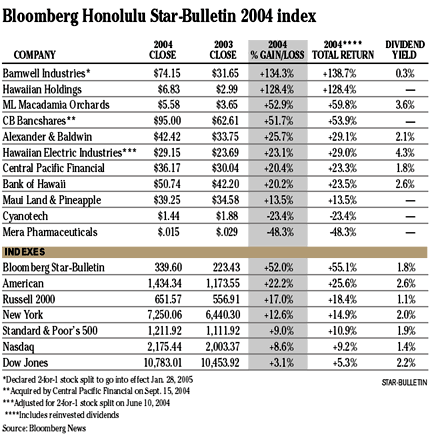Barnwell Industries hits
the right combination
for soaring stock
The Honolulu firm combines
oil and gas exploration with
real estate holdings
Barnwell Industries Inc. hasn't shown up on investors' radar screens in recent years.
But combine rising oil costs and soaring Hawaii real estate prices and people start to take notice.
That's just what happened in 2004 as Barnwell soared 134.3 percent to rocket past Hawaiian Holdings Inc. in the final two weeks of the year to post the best local stock performance in 2004. The company picked up in 2005 where it left off last year, by jumping 7.55 percent this year to $79.75.
Barnwell, which has been based in Honolulu for nearly 25 years, generates 61 percent of its revenue from its oil and natural gas operations in Alberta, Canada; 27 percent from its Big Island real estate holdings; 10 percent from its statewide water drilling operations and 2 percent from other interests. That unusual diversification, along with its listing on the lesser-regarded American Stock Exchange, has kept the company under wraps.
Until last year, that is, when Barnwell had record fiscal year earnings of $8.7 million, declared three dividends and announced a 2-for-1 stock split -- its first ever. The split will go into effect Jan. 28.
"I think it's a good combination of investments to have," said Alexander Kinzler, president and chief operating officer of Barnwell. "It just happens that both (oil and natural gas, as well as real estate) had very good years in 2004, which is attributable to the rise in the stock price. But they can act as hedges against each other. They're not linked in any particular way, which can be a good combination because they complement each other well."
Barnwell's stock was trading at a six-month low of $42.02 on Aug. 9 when it caught fire and jumped more than 76 percent to finish the year at an all-time high of $74.15.

"I think you've seen increased activity in the stock in the 30 days following our announcement because of the prospect for shareholders of increased liquidity in the stock, the potential for increased earnings in the future and the recognition that higher oil and gas prices are not likely to fall anytime soon," Kinzler said.
Hawaiian Airlines' parent also proved to be a double-your-money pick last year as speculators swooped in to scoop up shares on the bet that the company's stock wouldn't be canceled in light of airline's nearly 2-year-old Chapter 11 bankruptcy.
The gamble paid off when an investor group produced a reorganization plan that pays unsecured creditors in full and keeps Hawaiian Holdings' shares intact. That plan was backed by the airline's trustee and the unsecured creditors committee and helped Hawaiian Holdings' stock rise 128.4 percent to $6.83.
All in all, it was an outstanding year for Hawaii's most notable local stocks, which collectively rose 52 percent to end the year at an all-time high of 339.60. Nine of the 11 stocks in the Bloomberg Honolulu Star-Bulletin index had gains with seven of the companies hitting all-time highs. The index's performance dwarfed the single-digit advances by the three major U.S. indexes.
The Standard & Poor's 500 index rose 9 percent to 1,211.92, the Nasdaq composite index gained 8.6 percent to 2,175.44 and the Dow Jones industrial average edged up 3.1 percent to 10,783.01. Perhaps indicative of the smaller Honolulu companies' performance, the American Stock Exchange index jumped 22.2 percent to 1,434.34 and the Russell 2000 index of smaller companies jumped 17 percent to 651.57. The New York Stock Exchange index rose 12.6 percent to 7,250.06.
In any other year, ML Macadamia Orchards LP and City Bank parent CB Bancshares Inc. could have won top local honors.
ML Macadamia, the Big Island grower of macadamia nuts, rose 52.9 percent to an 11-year high of $5.89 in the final week of the year before finishing at $5.58.
The company gathered momentum during the second half of the year after two developments involving Mauna Loa Macadamia Nut Corp., the exclusive purchaser of ML Macadamia's nuts. First, Mauna Loa backed out of its acquisition of MacFarms of Hawaii when ML Macadamia went to court to block the deal. Then Hershey Foods Corp. purchased Mauna Loa, seemingly increasing the opportunity for ML Macadamia to get a higher price for its nuts in the future.
CB Bancshares, meanwhile, finally was acquired by rival Central Pacific Financial Corp. following a 1 1/2-year attempt to fight off the merger. CB Bancshares shareholders were big winners in the deal as Central Pacific kept raising its offer and CB Bancshares' stock soared 51.7 percent from the start of 2004 to $95 in mid-September when the merger with Central Pacific was finalized.
Central Pacific stock didn't fare badly either. Once the uncertainty of the merger was out of the way, Central Pacific's stock rose more than 31 percent to end 2004 up 20.4 percent. Central Pacific, which hit an all-time high of $36.66 on Dec. 23, closed Dec. 31 at $36.17.
Other companies hitting all-time highs during 2004 were Alexander & Baldwin Inc., which gained 25.7 percent; Hawaiian Electric Industries Inc., which rose 23.1 percent; Bank of Hawaii Corp., which increased 20.2 percent; and Maui Land & Pineapple Co., which gained 13.5 percent.
The only two companies to see their stocks finish down for 2004 are aquaculture industry rivals on the Big Island. Cyanotech Corp., the top performer last year with a 370 percent gain, fell 23.4 percent to $1.44 despite posting its fourth straight profitable quarter following 22 consecutive losing quarters. Mera Pharmaceuticals Inc., the lowest-price stock in the index, fell 48.3 percent to 1.5 cents.
[News] [Business] [Features] [Sports] [Editorial] [Do It Electric!]
[Classified Ads] [Search] [Subscribe] [Info] [Letter to Editor]
[Feedback]
